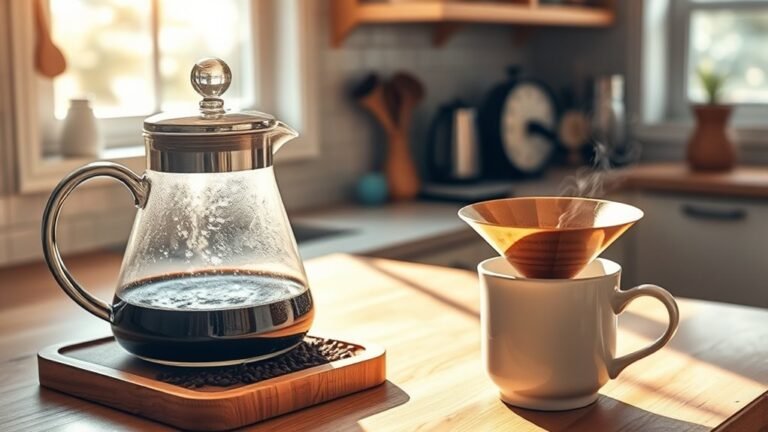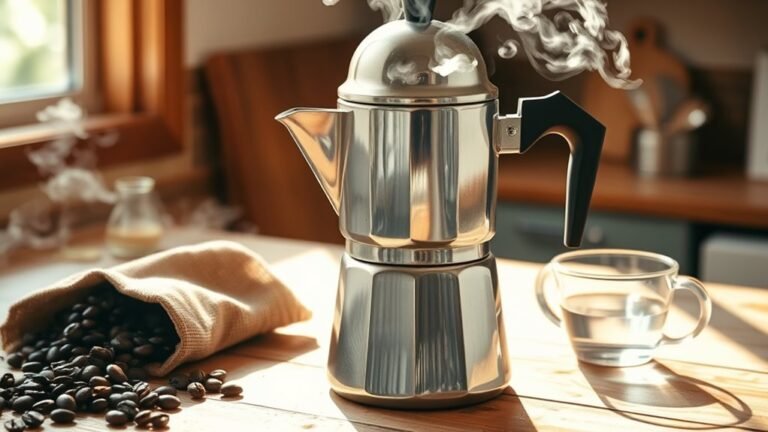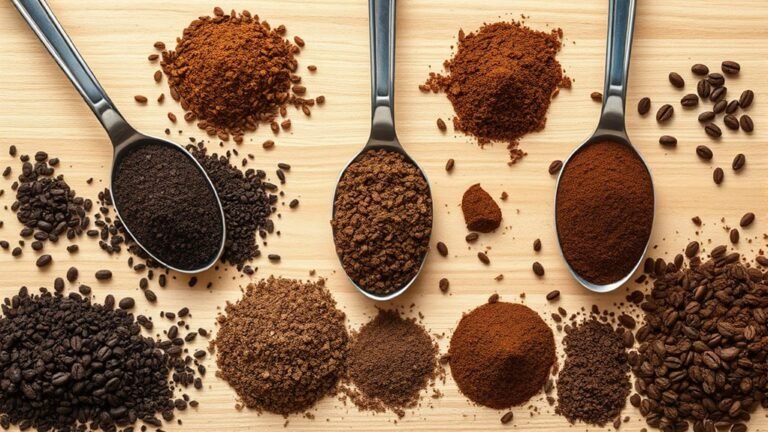Exploring Different Coffee Brewing Ratios
When exploring different coffee brewing ratios, you’ll find that precise control over coffee-to-water proportions directly affects your brew’s flavor and strength. Common ratios range from 1:14 for strong coffee to 1:20 for milder tastes, varying by method—espresso, pour-over, or French press. By systematically adjusting and measuring these ratios with a scale, you can consistently refine your preferred flavor profile. Understanding these nuances sets the foundation for mastering your ideal cup and refining your technique further.
Understanding Coffee Brewing Ratios

Although it might seem straightforward, understanding coffee brewing ratios is essential for consistently achieving your desired flavor profile. When you control the ratio of coffee grounds to water, you directly influence coffee extraction, which determines how much flavor is drawn out. Too much water dilutes the brew; too little leaves it overly concentrated or under-extracted. By precisely measuring these components, you guarantee brew consistency every time, freeing you from guesswork and variability. This methodical approach allows you to experiment confidently, adjusting ratios to suit your taste without compromising balance. Embracing this analytical mindset grants you the freedom to refine each cup, turning brewing into a controlled process rather than a chance outcome. Mastering ratios empowers you to access coffee’s full potential systematically and reliably.
Common Brewing Ratios for Various Methods
Once you grasp how brewing ratios impact extraction, the next step is to apply specific ratios tailored to different brewing methods. For drip coffee, a common ratio is 1:16, balancing strength and clarity, suitable for medium roast coffee types. French press often uses a slightly richer 1:15 ratio, accommodating coarser grounds and fuller-bodied coffee types. Espresso demands precision with a concentrated 1:2 ratio, reflecting its intense extraction process and dark roast compatibility. Pour-over techniques vary from 1:15 to 1:17, allowing flexibility depending on desired extraction and coffee types. Each brewing technique requires you to adjust ratios methodically, ensuring you extract ideal flavors without over- or under-extraction. By understanding these benchmarks, you gain freedom to experiment confidently across brewing techniques and coffee types, tailoring your cup to exact preferences.
How Brewing Ratios Influence Flavor and Strength
When you adjust the brewing ratio, you’re directly affecting the balance of flavors extracted from the coffee grounds. A higher coffee-to-water ratio intensifies strength but can overpower delicate notes, while a lower ratio may produce a milder, more nuanced cup. Understanding this relationship helps you tailor your brew to achieve the desired flavor profile and strength.
Ratio and Flavor Balance
Three key elements define how brewing ratios influence your coffee’s flavor and strength: the amount of coffee grounds, the volume of water, and their precise proportion. By adjusting these variables, you control extraction levels, directly shaping flavor profiles. For instance, a higher coffee-to-water ratio intensifies richness, while a lower ratio yields lighter notes. Different brewing techniques—like pour-over or French press—interact uniquely with these ratios, demanding fine-tuning for ideal balance. You’ll find that even small ratio shifts can emphasize acidity, sweetness, or bitterness, allowing you to tailor your cup. Mastering this balance grants you freedom to explore diverse tastes without sacrificing clarity. Ultimately, understanding and manipulating brewing ratios empowers you to craft coffee that aligns exactly with your flavor preferences and desired strength.
Strength Variation Effects
Adjusting your brewing ratio directly alters the strength of your coffee by changing the concentration of dissolved solids in the final cup. When you increase the coffee-to-water ratio, you intensify the strength perception, resulting in a bolder, more concentrated flavor. Conversely, lowering the ratio produces a lighter, more delicate cup. Maintaining brewing consistency is vital; slight variations in ratio can greatly impact strength, making precise measurement key to replicable results. Understanding how these adjustments affect extraction helps you control the balance between bitterness and acidity, tailoring strength to your preference. By methodically experimenting with ratios, you gain freedom to customize strength without sacrificing flavor harmony. This analytical approach guarantees every brew meets your desired intensity, empowering you to refine your coffee experience with confidence and precision.
Adjusting Ratios for Personal Taste Preferences
You’ll find that adjusting your coffee-to-water ratio directly impacts whether your brew tastes strong or mild. By methodically experimenting with these proportions, you can pinpoint the exact balance that suits your palate. Tracking these changes helps refine your approach for consistent, personalized results.
Strong vs. Mild
Although the standard coffee brewing ratio provides a reliable baseline, tailoring the strength to your taste requires careful modification of the coffee-to-water proportion. Strong coffee demands more grounds per unit of water, enhancing caffeine levels, aroma intensity, and bold flavor profiles. Mild coffee uses less coffee, yielding a lighter taste and subtle aroma, better suited for sensitive taste perception or specific coffee types. Your choice depends on personal preferences, brewing equipment, and techniques.
| Strength Level | Coffee-to-Water Ratio |
|---|---|
| Strong Coffee | 1:14 – 1:15 |
| Medium Coffee | 1:16 – 1:17 |
| Mild Coffee | 1:18 – 1:20 |
Adjusting within these ratios empowers you to control the balance between intensity and smoothness precisely.
Experimenting With Proportions
Finding the ideal coffee-to-water ratio often involves systematic experimentation beyond the general strength categories. You can start by adjusting your ratios incrementally, observing how subtle changes influence the final brew. Different brewing techniques—pour-over, French press, or espresso—affect extraction, so tailor your proportions accordingly. Keep track of how these adjustments impact flavor profiles, noting bitterness, acidity, and body. For example, increasing coffee grounds may intensify bitterness, while more water might dilute it. By methodically altering ratios, you gain control over your cup’s taste, allowing you to break free from one-size-fits-all recommendations. This process empowers you to define a personalized coffee experience, optimizing both strength and flavor balance to suit your unique preferences and desired freedom in brewing.
Practical Tips for Measuring and Scaling Ratios
Mastering three key measurements—coffee weight, water volume, and brew time—allows you to accurately control your brewing ratios. To achieve consistency, invest in precise measuring tools like a digital scale and a graduated pitcher. These tools eliminate guesswork, ensuring each variable is exact. When scaling recipes, apply systematic scaling methods: adjust coffee and water proportionally to maintain the desired ratio, whether brewing for one cup or a full pot. Keep brew time consistent or tweak it methodically to accommodate changes in volume. By approaching measurement and scaling analytically, you gain freedom to replicate or modify your process confidently. This methodical control over variables empowers you to craft your ideal cup, balancing precision with the creativity brewing demands.
Experimenting With Ratios to Perfect Your Brew

With precise measurements and consistent scaling in place, you’re ready to explore how varying your brewing ratios impacts flavor and strength. By methodically adjusting the coffee-to-water ratio, you gain control over brew strength and reveal diverse flavor profiles. Start by incrementally changing the ratio, observing how each adjustment alters the cup’s balance. This experimentation empowers you to tailor your brew to your preference, creating a personalized coffee experience.
- Increase coffee grounds to intensify brew strength and highlight bold notes
- Decrease coffee grounds for a lighter cup with subtle flavor profiles
- Maintain water volume to isolate ratio effects on extraction and taste
Approaching ratio adjustments analytically guarantees you refine your technique without guesswork, granting freedom to perfect your brew systematically.
Frequently Asked Questions
What Type of Coffee Grinder Is Best for Different Brewing Ratios?
Imagine using a steam-powered grinder from the 1800s—inefficient and uneven. Today, you want burr grinders because they offer consistent particle size, essential for precise brewing ratios. Blade grinders are cheaper but produce uneven grounds, which can throw off extraction. For freedom in experimenting with ratios, burr grinders let you adjust grind size methodically, ensuring you control flavor and strength precisely. Choose burr grinders to master your coffee’s potential.
How Does Water Temperature Interact With Brewing Ratios?
Water temperature critically affects your brewing process, especially when paired with specific brewing ratios. Higher temperatures extract flavors faster, so if you’re using a higher coffee-to-water ratio, you might want to lower the temperature slightly to avoid over-extraction. Conversely, with a weaker ratio, hotter water can help draw out enough flavor. By methodically adjusting water temperature alongside your brewing ratio, you gain precise control, enabling the freedom to customize your coffee’s taste exactly how you like it.
Can Brewing Ratios Affect Caffeine Content in Coffee?
Think of your coffee as a symphony, where brewing ratios conduct caffeine extraction and brewing strength. When you adjust the ratio of coffee grounds to water, you control how much caffeine dissolves into your cup. Higher brewing strength typically means more caffeine, while a weaker ratio yields less. By methodically tweaking these variables, you’re free to craft a caffeine experience that matches your desired energy and flavor balance precisely.
What Equipment Is Essential for Precise Coffee Measurement?
To measure coffee precisely, you’ll need reliable measurement tools, with scale accuracy being paramount. A digital kitchen scale that measures in grams to at least 0.1g increments guarantees consistent results. You’ll also benefit from a timer to control brew duration precisely. These tools free you to experiment confidently, knowing your measurements are exact, allowing you to explore coffee’s full potential without guesswork or inconsistency.
How Do Brewing Ratios Vary With Coffee Bean Origin?
When you’re aiming for that perfect cup, understanding how brewing ratios vary with coffee bean origin is key. Arabica varieties, known for their delicate sweetness, often call for a gentler ratio to preserve subtle flavors. Meanwhile, Robusta characteristics—bold and intense—can handle a stronger brew. Adjusting ratios methodically lets you reveal each bean’s unique profile, giving you the freedom to craft a coffee experience that truly suits your taste.






